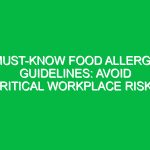“`html
Must-Know Flu Guidelines: Protect Your Team This Season!
Good morning team! Today, we’re going to discuss a topic that is crucial for our health and Safety this season: the flu. As the flu season approaches, it’s vital to understand how it can affect our workplace and what we can do to protect ourselves and our colleagues. Let’s dive into the must-know flu guidelines that will help keep our team healthy and productive!
Understanding Flu Guidelines
Flu guidelines are a set of recommendations and practices aimed at preventing the spread of influenza within the workplace. Influenza, commonly known as the flu, can lead to significant health issues, resulting in lost productivity and increased healthcare costs. Understanding these guidelines is essential not just for individual health, but also for the well-being of our entire team and the Sustainability of our operations.
Many people believe that the flu is simply a seasonal cold, but it can have serious consequences, especially for those with weakened immune systems. It’s important to recognize that the flu can spread rapidly in crowded environments, like our workplace, where close contact is common.
Key Hazards, Risks, and Safety Considerations
Flu season presents specific Hazards that we need to address as a team. Here are some key risks associated with influenza:
- High Transmission Rates: The flu virus spreads easily through respiratory droplets when an infected person coughs, sneezes, or talks.
- Workplace Outbreaks: An infected employee can spread the virus to colleagues, leading to widespread illness and absenteeism.
- Vulnerable Populations: Employees with underlying health conditions or weakened immune systems are at a higher risk of severe complications from the flu.
Ignoring these risks can have real-world consequences. For instance, an outbreak can lead to reduced workforce capacity, increased healthcare costs, and a decline in overall morale. It’s our responsibility to take proactive measures to ensure everyone’s safety.
Best Practices, Procedures, & Actionable Advice
Now that we understand the risks, let’s discuss some Best Practices that we can implement to minimize the impact of the flu in our workplace:
1. Get Vaccinated
The most effective way to prevent the flu is through vaccination. Encourage all team members to get their flu shots annually. Vaccination not only protects individuals but also helps build herd immunity within the workplace.
2. Practice Good Hygiene
- Handwashing: Wash your hands regularly with soap and water for at least 20 seconds, especially after coughing or sneezing.
- Use Hand Sanitizer: Keep alcohol-based hand sanitizer available in common areas.
- Avoid Touching Your Face: The flu virus can enter your body through the eyes, nose, and mouth.
3. Promote Respiratory Etiquette
- Coughing and Sneezing: Always cover your mouth and nose with a tissue or your elbow when you cough or sneeze.
- Dispose of Tissues Properly: Use waste bins to dispose of tissues immediately.
4. Maintain Clean Workspaces
Encourage everyone to keep their workspaces clean and sanitized. Use disinfectant wipes on shared surfaces like desks, keyboards, and phones regularly.
5. Stay Home When Sick
If you’re feeling unwell, especially with flu-like symptoms, please stay home to prevent spreading the virus. It’s important to prioritize your health and the health of your colleagues.
Regulations, Standards, and Compliance
Adhering to flu guidelines is not just about personal responsibility; it’s also about compliance with health and safety Regulations. According to OSHA (Occupational Safety and Health Administration) guidelines, employers are required to maintain a safe workplace, which includes protecting employees from communicable diseases like the flu. Compliance ensures that we are doing our part to create a healthy work Environment, which ultimately Benefits everyone.
Employee Engagement & Discussion
Now that we’ve covered these critical points, let’s open the floor for discussion. Here are a few questions to think about:
- What safety challenges have you encountered related to flu season in the workplace?
- How can we improve our flu Prevention strategies as a team?
- Do you have any personal experiences that highlight the importance of following these guidelines?
Your insights are invaluable in shaping a safer workplace for all of us, so please feel free to share your thoughts!
Conclusion & Key Takeaways
In summary, flu season poses significant risks that we must take seriously. By understanding and implementing the must-know flu guidelines, we can protect ourselves and our colleagues, ensuring a healthy work environment. Remember:
- Get vaccinated.
- Practice good hygiene.
- Promote respiratory etiquette.
- Maintain clean workspaces.
- Stay home when sick.
Thank you for your attention and commitment to maintaining a safe workplace. Let’s work together to prioritize our health this flu season and beyond. Stay safe, everyone!
“`


